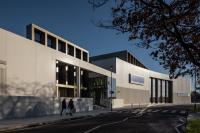Victorian Comprehensive Cancer Centre
Melbourne, Australia
The best hospitals ever made were designed with access to landscape, views, natural light and sunshine. Long before the obvious curative benefits of these features were clinically demonstrated, architects and landscape architects have intuitively positioned nature and landscape as central to the health care experience of patients, staff and researchers.
From Aalto’s Paimio Sanatorium (Paimio, Sweden, 1932) and backwards in time through the Victorian hospital building era, the focus was always on the window, the balcony, the bed terrace and sunshine. In the absence of optimised health science, these design features probably assisted recovery more than any of the balms, liniments and spurious medical practices that were rooted in the superstitions of the day, rather than in research or traditional natural medicines. Aalto’s modernist scheme at Paimio was set in a natural woodland, with ‘nature’ on show all around.
Post-war hospital design was often less successful. Budgets, poor siting, and the de-skilling of the profession of architecture in the 1950s and 1960s tended to depauperate the potential of the clinical type, resulting in ponderous, functional structures around the Australian capitals that contributed little to staff and patient experience, beyond a kind of factory-process form of service delivery.
How things have changed.
Rush\Wright Associates were engaged as the Landscape Architect for the Victorian Comprehensive Cancer Centre. This is one new project that is transforming thinking about what is possible in health design in Australia, establishing a quantum leap in hospital design that has scarcely occurred since the ground-breaking modernist explorations in Melbourne of the pre-war years. Ideas about landscape are central to the new project design, from the wrapped central open space, through to the roof terraces, small patient break-out spaces and the continuous access to views out through the trees, and across the skyline to the city beyond.
The island site has become a virtue here; not only does the building present ‘in the round’ as a land-marking sculpture in space, the expression of the parti gives every facade and every window on every floor a long and mostly valuable view. Recent research proves that even photographs of natural landscapes located in recovery settings improve outcomes; here almost every space has the real thing.
The primary designed landscapes for Victorian Comprehensive Cancer Centre include the north terrace on Level 01, a rainforest niche composed around islands of soft green planting, with luxurious, curving timber couches and tables providing rest spaces and places to meet. A diverse planting suggests the research potential of the rainforest, the origin of new treatments and cures. The design reinforces the key principle that biodiversity is really the essential platform for all human health, a concept that modern medicine sometimes overlooks.
On Level 07, the large floors of the low-rise podium of the building step back, creating a significant western roof terrace below the tower rise above. A new café creates a social hub on this floor, where staff from all areas can mingle, creating vital, relaxed crossovers between clinical and research practice. The roof garden supports this, locating generous and very varied social seating throughout, and a giant refectory table for meetings, lunches and project demonstrations for groups of up to 30. A barbecue stands ready, nearby.
The garden is conceived as a botanically diverse, floral display space, with a large group of giant artificial flowers creating an eye-catching central motif. These ‘wind flowers’ also form shade structures, and support for flowering climbers, creating significant focus and visual interest from windows above. Installed at the centre of the landscape experience at Victorian Comprehensive Cancer Centre, this ‘vase of flowers’ crystallises the central, familiar, ritual of hospital visitation into a cheerful and ever-present reminder of human love, and hope. These large forms also remind us of the origins of medicines in the world of plants, and the healing power of nature that is always available.
On Level 12, setbacks in the final tower rise of the building also create a large roof terrace. Here, the landscape is designed more like a casual backyard for staff, and is planted with productive fruit trees and edible understorey. This space will form a new type of hospital community garden, linking the health-giving power of fresh garden produce, with the social health benefits of staff working the gardens together in an informal group setting.
Other designed spaces in the project include the Level 02 Mobility Courtyard, where patient physical skills are tested and improved, and small ‘gardens’ on level 03, 05 and 06. These are all small rooms, a mix of enclosed and outdoor spaces, and all are designed simply for rest on brightly coloured, ‘park-like’ furniture settings. Here, the idea of ‘Parkville’ comes inside the hospital; stepping into these rooms one is stepping outside, both literally and metaphorically.
The aim of any hospital is for people to leave as soon as they are able; these gardens become constant reminders of reality outside, and the real places people want to be- healthy, and alive.
Recipient of the 2018 AILA National Landscape Architecture Awards – Garden Landscapes.
- Landscape Architects
- Rush\Wright Associates
- 位置
- 305 Grattan St, 3000 Melbourne, Australia
- 年份
- 2016
- 客户
- Plenary Health + Grocon-PCL State Government of Victoria
- Irrigation design and documentation
- Michael Ten Buuren
- Builder
- Grocon PCL
- Landscape subcontractor
- Baron Forge
- Joint venture
- McBride Charles Ryan
- Joint venture
- Silver Thomas Hanley
- Joint venture
- Design Inc














